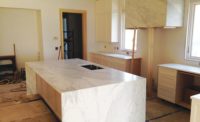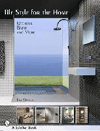
In many cases, a waterproofing membrane is applied to the floor and base areas of a shower to create a pan effect. The waterproofing membrane can also be carried up the walls to protect the entire shower application.
When evaluating a hotel, the bathroom - and especially the shower - really make a statement about the quality and comfort of the room. Hospitality showers today are more than just necessary amenities. They can be beautiful and luxurious mini-escape locations. And, nothing makes this statement better than natural stone. With that in mind, it is critical to construct the wet area at optimal levels to create a long-lasting and durable installation.
One of the most critical concerns is keeping areas that are adjacent to or below the showers from getting wet. This requires the use of an installation system for the stone that incorporates an integral waterproofing layer.
Showers are considered to be “constant wet areas.” Therefore, building codes and design specification mandate that a waterproofing membrane be used. In many cases, a waterproofing membrane is applied to the floor and base areas to create a pan effect. The waterproofing membrane can also be carried up the walls to protect the entire shower application. One of the most common shower installation methods follows the Tile Council of North America’s method (TCNA) B-415 (see Diagram 1).
The TCNA’s Handbook for Ceramic Tile Installations provides many details that depict the use of a waterproofing membrane in an array of installation methods, including walls, floors, decks, tubs, showers and pools. Follow the specification and detail for the respective TCNA method.
In addition to the constant wet area applications, a waterproofing membrane can also be used in “intermittent wet area” applications. For instance, the floor areas outside of a tub or shower are great candidates for waterproofing membrane treatments. In many cases, water spills or splashes out onto these areas. Left untreated, the water can migrate through the stone and grout, affecting the substrate and the spaces below. Even minor water damage can prove to be very costly to repair.
In addition, many of the waterproofing membranes available today also serve as anti-fracture membranes and help to reduce the potential for hairline shrinkage and spider web cracks from telegraphing through to the stone surface. It has been proven that the use of waterproofing membranes within stone installations significantly reduces the potential for mold and mildew in wet areas. Some of today’s waterproofing membranes come equipped with anti-microbial protection and help to fight off the effects of stain-causing mold and mildew.
Waterproofing membranes also help to keep buildings healthy. They help to prevent the occurrence of poor indoor air quality by protecting against the effects of water damage, including rot, deterioration of building materials, mold and mildew. A few select waterproofing membranes are certified by specific government endorsed air-quality monitoring services. These membranes really help to keep the building environment healthy.
Generally, waterproofing membranes for the stone industry fall into three categories:
• Liquid latex rubber applied type
• Sheet type
• Reinforced latex-fortified Portland cement type
Within these categories are many membranes that are thin and load-bearing, adding no appreciable thickness to the installation, and they are fully compatible with latex-fortified Portland cement-based thin-set and medium-bed mortars. Usually, a full latex-fortified mortar bed can also be applied over these waterproofing membranes in the shower pan.
In order to apply the waterproofing membrane, the appropriate substrates should be properly prepared in a similar manner, as if a direct bond latex-fortified Portland cement thin-set mortar were to be applied.
The use of pre-fabricated shower pans provides an alternative to constructing the shower pan from conventional means. Manufacturers of these pans have designed their wares to fit a variety of shower configurations. The pans are set into place and are simply tied into the drain assembly. The wall sheathing is then brought down onto the pan. The joint between the wall sheathing and pan is usually treated in accord with the pan manufacturer’s instructions. This joint treatment can vary according to the type of pan that is utilized. The shower is now ready to accept the stone. Many of these pre-fabricated pan assemblies are constructed out of a durable PVC or fiberglass material. The stone can be adhered to these surfaces with an epoxy adhesive.
This relatively new phenomena of lightweight, leak-proof and tile-ready shower pans is particularly attractive for hospitality construction, as installation time is shortened (less labor involved) and less costly. Some other things to keep in mind in order to create a long-lasting stone shower assembly are as follows:
• Always install the shower pan over a pre-sloped substrate (if it is not a pre-fabricated shower pan, which is constructed with a sloped “floor” for drainage). The slope is generally ¼ inch per foot (6 mm per 300 mm). This simple step will not allow any water or moisture to sit in the shower pan. It will allow water to flow towards the weep holes in the lower portion of the clamping ring-style drain. The use of ASME A112.6.3-2001-compliant drains is recommended. Placing crushed stone around the weep hole areas keeps the weep holes functioning correctly by preventing mortar from filling the weeps (see Figure 1).
• Use a latex-fortified Portland cement-based thin-set mortar for best performance in these areas. Avoid the use of organic (mastic type) adhesives in the shower and other wet areas. The latex-fortified Portland cement thin-set mortars are high-strength products, fully compatible with the waterproofing membranes, and they are inherently resistant to the growth of mold and mildew.
• Finish off the installation with a grout that resists all of the common problems associated with conventional grouts. New generation cross-linking-type grouts offer the high performance, color uniformity, durability and stain resistance of an epoxy grout with extraordinary ease of use. Added design elements include optional components that provide metallic and “Glow-in-the-Dark” enhancements. These grouts meet ANSI A118.3 performance standards, while providing perfect color uniformity - no blotchiness or shading. No sealing is required with these grouts. Additionally, this grout helps to inhibit the growth of stain-causing bacteria, mold and mildew in the grout joint with antimicrobial product protection. Matching silicone sealant is also available to treat the corners, coves and any transition areas that are prone to cracking.
Consult your stone adhesive manufacturer for more information on a single source, fully compatible and warranted installation system.

